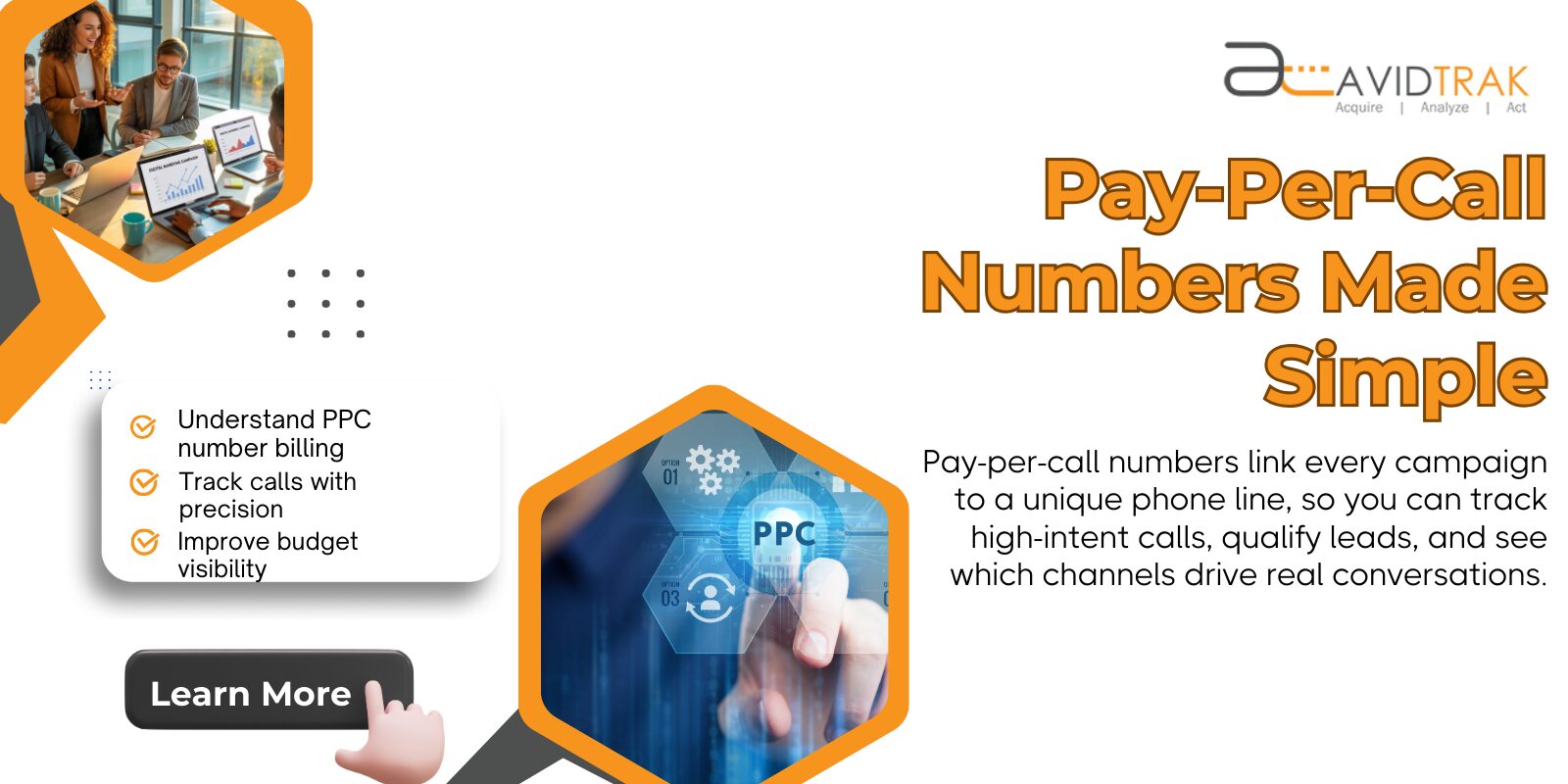Many businesses still rely on web forms to track interest, but this method often delays conversions, especially in industries where phone conversations drive faster results. When customers need legal advice, home repairs, or health-related services, they prefer to speak directly with someone.
Phone calls often lead to higher conversion rates than online clicks. However, many businesses lack visibility into which ads, keywords, or traffic sources drive those calls, or how those calls influence actual revenue.
Pay-per-call numbers address this issue by linking each call-based campaign to a unique number, enabling advertisers to pay only for qualified inbound calls. The model supports PPC campaigns, affiliate networks, and local service providers focused on measurable customer acquisition.
AvidTrak provides affordable pay-per-call numbers with built-in call tracking, smart routing, AI-based transcription, and reporting tools—all designed to help marketing teams attribute calls, optimize ROI, and recover lost leads.
This guide explains how to get a pay-per-call number in 2025, set up accurate tracking, monitor the right metrics, and apply proven strategies to increase qualified call volume.
Summary
- Pay-per-call numbers are unique call tracking identifiers that connect inbound calls to specific marketing campaigns, allowing businesses to measure performance and bill based on qualified leads.
- Toll-free, local, and dynamic numbers support different campaign strategies, ranging from national visibility to localized targeting and keyword-level attribution.
- A typical campaign involves a customer calling a tracked number, which is routed to the appropriate agent, recorded, transcribed, and scored to evaluate lead intent.
- Marketers use pay-per-call campaigns to drive higher conversion rates, qualify leads through live interactions, and attribute phone calls directly to advertising sources.
- Setting up a campaign involves selecting a call tracking platform, assigning campaign-specific numbers, configuring call routing, and tracking performance through key metrics.
- Avoiding common issues such as using a single number across campaigns, skipping lead qualification, or ignoring call data can help improve attribution and lead quality.
- AvidTrak is built to support pay-per-call campaigns with affordable pricing, expert product support, and tools that help marketers manage every step of the process. Features such as dynamic number insertion, IVR, call recording, AI-powered transcription, and CRM integration give teams the control to track, qualify, and optimize every inbound call.
What Are Pay-Per-Call Numbers?
Pay-per-call numbers are unique call tracking numbers assigned to marketing campaigns to measure and bill based on inbound calls instead of ad clicks, allowing businesses to connect marketing activity with real-time phone conversations, using call data to qualify leads and monitor performance.
There are several types of numbers used in pay-per-call campaigns:
-
Toll-free numbers
Toll-free numbers are commonly used in national campaigns to build trust and make businesses more accessible across regions, with vanity toll-free numbers often used for brand recognition.
-
Local numbers
Local numbers match the caller’s area code, improving answer rates and helping businesses appear more relevant and familiar to regional audiences.
-
Dynamic numbers
Dynamic Number Insertion (DNI) displays different numbers based on the visitor’s traffic source, campaign, or keyword, which is effective for tracking performance in Google Ads, Bing Ads, and affiliate marketing.
Performance marketers and lead generation teams use these numbers across multiple channels such as landing pages, search ads, social media platforms, email follow-ups, and offline campaigns, including print and radio. Each number allows for accurate attribution of call-driven leads, better evaluation of campaign return, and more precise analysis of conversations that drive results.
How Pay-Per-Call Advertising Works
In a pay-per-call campaign, each step is tied to a specific action that can be tracked, scored, and billed. The PPC process works as follows:
- A customer sees a phone number in a paid ad, landing page, or digital channel such as Google Ads, email, or social media platforms.
- The customer makes a call, often looking for fast answers or to book a service directly.
- The call is routed and tracked using a unique call tracking number assigned to the campaign. Routing may follow a sequence such as IVR systems, Round Robin, or call transfer to a sales representative.
- The call is recorded and transcribed using AvidTrak’s AI, then keyword detection and call scoring are applied to assess lead quality, identify sales opportunities, and flag customer concerns.
- A lead is scored and billed when it meets the predefined conversion criteria, such as a minimum call duration or reaching a qualified call agent.
Pay-per-call advertising operates differently from standard PPC models, where marketers are charged for each call regardless of lead quality. In a pay-per-call setup, advertisers pay only for inbound calls that meet specific campaign goals and show clear buyer intent. The model works well for performance marketing teams, affiliate networks, and businesses running call-based campaigns focused on qualified leads.
Benefits of Pay-Per-Call Campaigns
Marketers running call-based campaigns often see better performance when leads connect by phone rather than filling out forms. Pay-per-call advertising allows businesses to track, qualify, and convert high-intent prospects using tools built for attribution and lead quality, not just traffic volume.
The following benefits highlight why pay-per-call campaigns work well for marketers focused on performance data, call attribution, and cost control.
Higher Conversion Rates
Calls often lead to quicker decisions, as customers who dial a number usually have immediate intent, which leads to better conversion rates. These inbound phone calls help reduce delays and quickly close leads within a shorter call journey.
Real-Time Lead Qualification
A live call provides an instant opportunity to engage and qualify the lead, unlike web leads that require follow-ups. With tools such as call recordings and lead scoring, sales teams can assess lead intent during the conversation, improving response time and lowering the risk of losing qualified prospects.
Better Attribution & ROI Tracking
Each call tracking number is assigned to a specific campaign, allowing marketers to see which ads or social media platforms drive high-value calls, link those calls to performance data, and optimize spend and creatives accordingly.
Ideal for Local and Service-Based Businesses
Businesses that depend on regional leads, such as law offices, HVAC services, or dental clinics, benefit from local numbers, call routing, and IVR systems that connect each call lead to the nearest available agent. This improves response time and supports higher customer engagement.
Pay-per-call campaigns offer a practical way to prioritize lead quality, faster conversions, and measurable results. AvidTrak supports this approach by providing the tools needed to manage every stage of the call, from assigning tracking numbers and routing calls through IVR, to recording conversations, transcribing them with AI, and tagging outcomes for reporting. AvidTrak helps teams monitor campaign effectiveness, reduce lead handling delays, and focus budget on what actually drives results.
Where to Use Pay-Per-Call Numbers in Your Marketing
Pay-per-call numbers can be placed across various digital channels and offline campaigns to identify high-intent leads. Each number helps attribute inbound calls to a specific source, making it easier to track marketing outcomes and improve customer acquisition.
The following channels commonly support pay-per-call number placement for lead tracking and attribution:
- Google Ads, including search and call-only campaigns, where unique numbers enable keyword-level attribution and reduce wasted clicks
- Meta Ads and other social media platforms that include call buttons, allowing for direct engagement from mobile users
- Landing pages, where Dynamic Number Insertion (DNI) adjusts the number based on the traffic source or keyword
- Local service listings, where using a local number improves trust and call pickup rates
- Email marketing campaigns, especially follow-ups that encourage live conversations
- Offline campaigns, such as print ads, flyers, and billboards, where static numbers still support full call tracking
Assigning the correct call tracking number to each channel allows marketers to measure which efforts generate qualified calls and deliver the strongest return on ad spend.
Setting Up Your First Pay-Per-Call Campaign
A pay-per-call campaign requires a structured approach to support accurate tracking, lead qualification, and performance measurement. The following steps highlight how to configure your campaign for reliable call tracking and measurable results across performance-driven channels.
STEP # 1
Choose a call tracking platform like AvidTrak that supports features such as call routing, call analytics, AI-powered transcription, and campaign-level reporting.
STEP # 2
Get toll-free, local, or dynamic tracking numbers using Dynamic Number Insertion (DNI), based on your campaign needs.
STEP # 3
Assign each number to a campaign or traffic source, such as Google Ads, Meta Ads, or email, to support accurate attribution and lead tracking.
STEP # 4
Configure call routing and forwarding rules and use IVR systems, Round Robin, or weighted call routing to direct calls to the right call agent or department.
STEP # 5
Install tracking pixels or scripts to connect call data to platforms like Google Ads, Bing Ads, or your CRM.
STEP # 6
Monitor call quality, lead intent, and cost per call using call duration, scoring, and endpoint behavior metrics.
STEP # 7
Use custom data reports to optimize performance by reviewing which call-based campaigns generate the most qualified call prospects at the lowest acquisition cost.
Setting up a pay-per-call campaign is not just about assigning numbers; it’s about building a system that connects calls to outcomes. AvidTrak simplifies this process with tools for tracking, routing, transcription, and reporting, helping marketers manage calls effectively and focus spend on campaigns that drive real results.
Key Metrics to Monitor for Pay-Per-Call Success
An efficient pay-per-call strategy requires performance metrics that accurately reflect lead quality, conversion efficiency, and return on ad spend. The following KPIs help assess the effectiveness of each campaign.
-
Call duration
Longer calls typically reflect higher interest or engagement, making this a helpful indicator when evaluating lead quality.
-
Cost per lead (CPL)
Tracking CPL by channel helps manage customer acquisition costs and compare how call-based campaigns perform against budget.
-
Conversion rate
A successful campaign delivers a higher percentage of callers that meet your defined conversion criteria, such as booking an appointment or completing a sale.
-
Missed vs. answered calls
A high volume of missed calls may indicate routing issues or call center limitations. Tracking this metric helps reduce delays and prevent lead loss.
-
Source and medium attribution
Accurate source attribution links call tracking numbers to the specific PPC campaigns, keywords, or affiliate marketing sources that drove the call, ensuring maximum ROI.
-
Qualified call rate
The percentage of calls that match the target lead profile is evaluated using factors such as call scoring, duration, or tagged outcomes in the tracking platform.
Common Mistakes That Undermine Pay Per Call Performance
A pay-per-call campaign can fall short if key elements are missed during setup or execution. To maintain lead quality and manage customer acquisition costs, avoiding the following mistakes that affect tracking accuracy and overall conversion performance is essential.
Using One Static Number Across Campaigns
A single call tracking number used across multiple campaigns limits visibility into performance. Without unique numbers assigned to each PPC campaign, keyword, or digital channel, it becomes difficult to attribute inbound calls accurately.
Not Qualifying Leads Properly
Allowing every call through without filters can result in spam, robocalls, or irrelevant leads. Without lead scoring or AI-powered transcription, unfiltered traffic such as spam or irrelevant inquiries can reduce efficiency and affect call quality across campaigns.
Skipping After-Hours Routing
Calls received outside regular business hours often go unanswered if call routing is not configured for time-based logic. AvidTrak provides after-hours routing options that help teams reduce missed calls and recover qualified leads.
Not Tracking Calls as Conversions
Calls that meet the conversion criteria should be reported as conversions. If callers are not pushed back to platforms such as Google Ads, GA4, or CRM, cost per lead and campaign performance cannot be measured accurately.
Delivering a Poor Caller Experience
Callers expect a fast and responsive experience, but long hold times, missing greetings, or confusing menus often lead to early drop-offs. Tools such as IVR systems, call transfer, and voicemail settings help create a smoother caller journey and support stronger customer engagement.
How AvidTrak Enhances Your Pay-Per-Call Strategy
A pay-per-call campaign is only effective when each part of the process, from tracking to qualification, is handled accurately and consistently. AvidTrak supports this approach by offering affordable tools backed by expert product support and years of experience solving complex attribution challenges. Marketing teams gain the clarity and control needed to improve lead quality, reduce waste, and tie each call to measurable outcomes.
Marketers using AvidTrak gain access to:
Affordable Call Tracking Plans
AvidTrak offers competitively priced plans for agencies and SMBs that need reliable call tracking without committing to high-volume contracts. Pricing flexibility supports both basic call-based campaigns and more complex routing or attribution needs.
Dynamic Number Insertion (DNI)
 Marketers can use Dynamic Number Insertion to assign unique call tracking numbers at the keyword, ad group, or session level, providing precise attribution across Google Ads, PPC campaigns, and affiliate marketing traffic.
Marketers can use Dynamic Number Insertion to assign unique call tracking numbers at the keyword, ad group, or session level, providing precise attribution across Google Ads, PPC campaigns, and affiliate marketing traffic.
Call Recording and Transcription
 Every inbound call can be recorded and transcribed using AvidTrak’s AI-powered transcription. Teams can review calls, flag intent-driven keywords, and apply call scoring to evaluate lead quality based on actual conversations.
Every inbound call can be recorded and transcribed using AvidTrak’s AI-powered transcription. Teams can review calls, flag intent-driven keywords, and apply call scoring to evaluate lead quality based on actual conversations.
IVR, Routing, and Missed Call Alerts
 AvidTrak’s interactive voice response and advanced call routing options, including Round Robin and weighted call distribution, ensure that calls are directed to the right agent or department. If a call goes unanswered or is dropped, instant alerts notify the team to follow up with the caller, helping recover potential sales or service bookings and reducing response time.
AvidTrak’s interactive voice response and advanced call routing options, including Round Robin and weighted call distribution, ensure that calls are directed to the right agent or department. If a call goes unanswered or is dropped, instant alerts notify the team to follow up with the caller, helping recover potential sales or service bookings and reducing response time.
Integrations with Google Ads, GA4, and CRMs
 AvidTrak connects seamlessly with Google Ads, GA4, and CRMs such as Salesforce, HubSpot, and Zoho, pushing call data into the platforms marketers already use to manage customer acquisition.
AvidTrak connects seamlessly with Google Ads, GA4, and CRMs such as Salesforce, HubSpot, and Zoho, pushing call data into the platforms marketers already use to manage customer acquisition.
Speech Analytics and Reporting Dashboard
 AvidTrak’s dashboard includes speech analytics, keyword tagging, and filters for analyzing call attributes such as call duration, source effectiveness, and cost per lead. These tools help marketers focus their spending on campaigns that deliver the most qualified call leads.
AvidTrak’s dashboard includes speech analytics, keyword tagging, and filters for analyzing call attributes such as call duration, source effectiveness, and cost per lead. These tools help marketers focus their spending on campaigns that deliver the most qualified call leads.
Turn Your Call Campaigns Into Revenue
Pay-per-call delivers when every call is tracked, routed, and measured with precision. AvidTrak provides a complete platform to get it right, with expert support, flexible pricing, and the tools to connect every lead to real performance.
Sign up for a free trial and see how AvidTrak builds smarter campaigns that turn calls into results.
Frequently Asked Questions
1. What is the difference between a pay-per-call and a regular phone number?
A pay-per-call number is a unique call tracking number assigned to a specific campaign, ad group, or traffic source. Unlike a regular number, it identifies call data, supports attribution, and helps measure campaign performance based on qualified inbound calls.
2. Can I use different call tracking numbers for SEO, PPC, and affiliate marketing?
Yes. AvidTrak allows you to assign separate numbers for Google Ads, organic traffic, affiliate networks, and other digital channels. This helps identify which sources drive the most qualified call leads and improves reporting accuracy.
3. Does pay-per-call marketing work for service-based businesses?
Yes. Pay-per-call advertising is especially effective for local and service-focused industries such as legal, healthcare, and home services. With tools like IVR systems, call routing, and local numbers, businesses can connect callers to the right agent in real time.
4. How does AvidTrak handle spam or low-quality calls?
AvidTrak includes tools such as call scoring, AI-powered transcription, and spam call filtering to help teams qualify leads. These features help reduce time spent on irrelevant calls and improve overall call quality.
5. What integrations does AvidTrak support for pay-per-call tracking?
AvidTrak integrates with Google Ads, GA4, Salesforce, HubSpot, and Zoho CRM. These integrations allow you to sync call data, track conversions, and link calls to broader customer acquisition and performance marketing efforts.
6. Is a minimum number of calls required to start with AvidTrak?
No. AvidTrak’s pricing is built for flexibility, making it a suitable choice for both high-volume agencies and small businesses. You can start tracking calls without volume commitments and scale as your campaigns grow.



